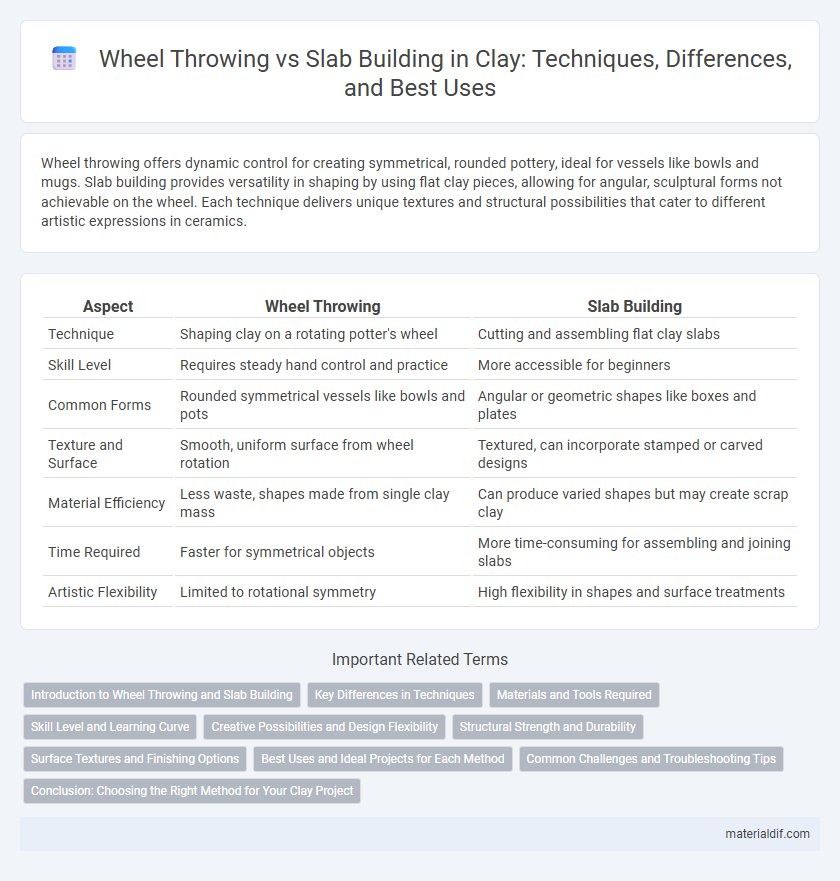Wheel throwing offers dynamic control for creating symmetrical, rounded pottery, ideal for vessels like bowls and mugs. Slab building provides versatility in shaping by using flat clay pieces, allowing for angular, sculptural forms not achievable on the wheel. Each technique delivers unique textures and structural possibilities that cater to different artistic expressions in ceramics.
Table of Comparison
| Aspect | Wheel Throwing | Slab Building |
|---|---|---|
| Technique | Shaping clay on a rotating potter's wheel | Cutting and assembling flat clay slabs |
| Skill Level | Requires steady hand control and practice | More accessible for beginners |
| Common Forms | Rounded symmetrical vessels like bowls and pots | Angular or geometric shapes like boxes and plates |
| Texture and Surface | Smooth, uniform surface from wheel rotation | Textured, can incorporate stamped or carved designs |
| Material Efficiency | Less waste, shapes made from single clay mass | Can produce varied shapes but may create scrap clay |
| Time Required | Faster for symmetrical objects | More time-consuming for assembling and joining slabs |
| Artistic Flexibility | Limited to rotational symmetry | High flexibility in shapes and surface treatments |
Introduction to Wheel Throwing and Slab Building
Wheel throwing involves shaping clay on a rotating potter's wheel, allowing for symmetrical and rounded forms such as bowls, vases, and pots with smooth, continuous surfaces. Slab building uses flat, rolled-out clay sheets that are cut and joined to create angular and structural shapes, offering more geometric and architectural possibilities. Both techniques require different skill sets and provide unique textures and design flexibility in ceramic art.
Key Differences in Techniques
Wheel throwing involves shaping clay on a rotating potter's wheel, allowing for symmetrical and rounded forms with smooth surfaces, while slab building requires rolling out flat clay sheets that are cut and joined to create angular, geometric shapes. Wheel throwing demands consistent speed control and hand positioning to center and pull the clay, whereas slab building focuses on precise measuring, scoring, and slipping to assemble pieces securely. Each technique offers unique textural and structural possibilities, influencing the final aesthetic and functional qualities of the ceramic work.
Materials and Tools Required
Wheel throwing requires a pottery wheel, specific throwing bats, and high-quality stoneware or porcelain clay known for its plasticity and strength. Slab building utilizes rolling pins or slab rollers to flatten clay and requires wire cutters and various shaping tools, with earthenware or white clay often preferred for its ease in cutting and joining slabs. Both techniques demand water containers and sponges for smoothing and maintaining clay consistency during the forming process.
Skill Level and Learning Curve
Wheel throwing requires a higher skill level and a steeper learning curve due to the need for precise hand coordination and control of the spinning wheel. Slab building offers a more accessible entry point for beginners, relying on simpler techniques like rolling and cutting clay slabs. Mastery in wheel throwing often takes longer, while slab building allows for faster experimentation and creativity with fewer technical challenges.
Creative Possibilities and Design Flexibility
Wheel throwing allows for symmetrical, rounded forms ideal for functional pottery, offering precise control over shape and size. Slab building enables more angular, geometric, and asymmetrical designs, expanding creative possibilities with unique textures and surface treatments. Combining both techniques maximizes design flexibility, blending smooth curves with sharp edges for innovative clay art.
Structural Strength and Durability
Wheel throwing produces ceramic pieces with uniform wall thickness, enhancing structural strength and reducing stress points compared to slab building. Slab building involves joining flat clay pieces, which can create weak seams unless meticulously scored and slipped, potentially compromising durability. The continuous rotation in wheel throwing aligns clay particles, resulting in a denser and more resilient final product.
Surface Textures and Finishing Options
Wheel throwing creates smooth, symmetrical surfaces with natural concentric rings that can be enhanced by trimming or carving, allowing for refined textures and polished finishes. Slab building offers a broader range of surface textures through hand-applied methods such as stamping, impressing, and scoring, resulting in more varied and tactile finishes. Both techniques provide unique finishing options like glazing or burnishing to achieve different aesthetic and functional effects.
Best Uses and Ideal Projects for Each Method
Wheel throwing excels in creating symmetrical, rounded pottery such as bowls, vases, and mugs, offering precision and uniformity ideal for functional tableware. Slab building suits constructing angular or large-scale pieces like ceramic tiles, sculptural forms, and architectural components, allowing greater flexibility for creative shapes and textures. Choosing wheel throwing benefits projects demanding smooth curves and consistent thickness, while slab building supports experimental designs requiring flat surfaces and varied structural elements.
Common Challenges and Troubleshooting Tips
Wheel throwing often presents challenges such as centering the clay, maintaining even wall thickness, and controlling the shape as it spins rapidly on the wheel. Slab building requires precision in rolling consistent clay thickness and careful joining to prevent cracks or weak seams during drying and firing. To troubleshoot, potters should use steady hand pressure and practice timing for wheel throwing while employing scoring, slipping, and supportive armatures to reinforce slab constructions.
Conclusion: Choosing the Right Method for Your Clay Project
Wheel throwing offers rapid shaping and symmetrical forms ideal for functional pottery, while slab building provides greater control for creating geometric and sculptural pieces. Selecting the right method depends on your project's design complexity and desired texture, with wheel throwing suited for smooth, uniform surfaces and slab building excelling in angular, textured constructions. Understanding these techniques ensures efficient workflow and enhances the artistic expression of your clay project.
Wheel Throwing vs Slab Building Infographic

 materialdif.com
materialdif.com